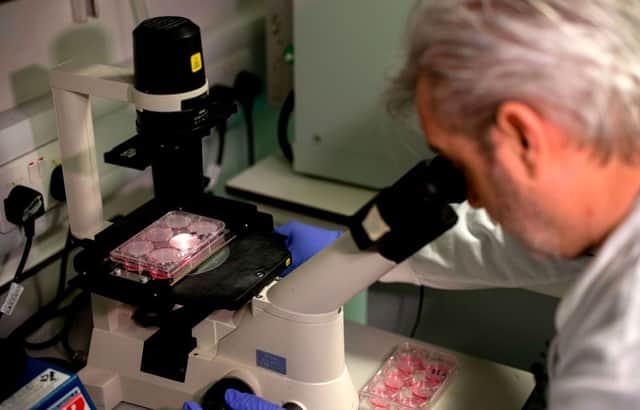How is the Oxford University vaccine being trialled, and could it be ready by autumn?


ChAdOx1 nCoV-19 is made from ChAdOx1, a weakened version of a common cold virus (adenovirus) that causes infections in chimpanzees.
It has been genetically changed so it is impossible for it to grow in humans.
Advertisement
Hide AdAdvertisement
Hide AdResearchers hope their version will make the body recognise and develop an immune response to the spike protein - recognisable in images of the coronavirus - that will help stop Covid-19 from entering human cells, therefore preventing infection.
Researchers at the Oxford Vaccine Group began testing the vaccine candidate ChAdOx1 nCoV-19 in human volunteers on April 24 to see whether it can protect healthy people from Covid-19.
The programme will allow researchers to assess the safety of the candidate, and its ability to generate an immune response.
Who is participating?
Over 1,100 participants have been recruited across multiple study sites in Oxford, Southampton, London and Bristol.
Advertisement
Hide AdAdvertisement
Hide AdThe volunteers have been randomly allocated to receive either the ChAdOx1 nCoV-19 vaccine, or a licensed meningitis vaccine that will be used as a comparison.
A separate small group of 10 volunteers were set to get two doses of the candidate four weeks apart, the first administered at the start of the trial.
They volunteers must be in good health, not be pregnant or breastfeeding, and must not have previously taken part in a trial with an adenoviral vaccine or received any other coronavirus vaccines.
How does the trial work?
The dose used in the trial was chosen based on previous experiences with other ChAdOx1 based vaccines.
Advertisement
Hide AdAdvertisement
Hide AdParticipants will not know whether they have received the Covid-19 vaccine or the control vaccine until the end of the trial.
On April 24, the first two participants were vaccinated, one with the ChAdOx1 nCoV-19 vaccine and one with the control vaccine. On day three, six more volunteers were vaccinated, half with the Covid-19 vaccine and three with the control vaccine.
On the fifth day, researchers began vaccinating larger numbers of participants.
The participants were given an e-diary to record any symptoms they experience in the seven days after receiving the vaccine, and if they feel unwell for the following three weeks.
Advertisement
Hide AdAdvertisement
Hide AdDuring a series of follow-up visits, blood samples will be taken to assess their immune response, and their observations checked.
The statisticians will compare the number of infections in the control group with the number of infections in the vaccinated group.
Therefore, it is necessary for a small number of study participants to develop Covid-19.
If they develop Covid-19 symptoms during the study, they can contact a member of the clinical team, who will check if they have become infected with the virus.
Advertisement
Hide AdAdvertisement
Hide AdIf a participant becomes very unwell they will be reviewed by staff in hospital.
When could a vaccine become available?
If tests of ChAdOx1 nCoV-19 are fruitful, up to 30 million doses for the UK could be available by September, the Government has said.
Business Secretary Alok Sharma said the first clinical trials were "progressing well" and that all phase one volunteers had received their vaccine dose "on schedule earlier this week".
However, many experts believe we won’t see a widely available vaccine until 2021 at the earliest.
Advertisement
Hide AdAdvertisement
Hide AdProfessor Robin Shattock, head of mucosal infection and immunity at Imperial College London, said he thought a vaccine was not likely to be widely available until next year.
He told Today: "I think we have a very high chance of seeing a number of vaccines that work because we know a lot about this target and I think there's good scientific rationale to say it's not such a hard target as others.
"My gut feeling is that we will start to see a number of candidates coming through with good evidence early towards next year - possibly something this year - but they won't be readily available for wide scale use into the beginning of next year as the kind of most optimistic estimation."